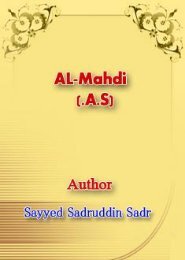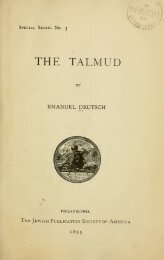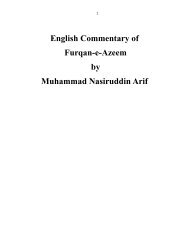- Page 2:
Islam inWorld Cultures
- Page 5 and 6:
Copyright 2004 by R. Michael Feener
- Page 8 and 9:
ContentsC o n t r i bu to r s,ixIsl
- Page 10 and 11:
ContributorsDavid Buchman is a cult
- Page 12 and 13:
Chapter OneIslamHistorical Introduc
- Page 14 and 15:
H i s to r i cal Introduction and O
- Page 16 and 17:
H i s to r i cal Introduction and O
- Page 18 and 19:
H i s to r i cal Introduction and O
- Page 20:
H i s to r i cal Introduction and O
- Page 23 and 24:
1 2Islam i n World Cult u r e ss u
- Page 25 and 26:
1 4Islam i n World Cult u r e stici
- Page 27 and 28:
1 6Islam i n World Cult u r e sMusl
- Page 29 and 30:
1 8Islam i n World Cult u r e stert
- Page 31 and 32:
2 0Islam i n World Cult u r e sconf
- Page 33 and 34:
A modern permutation of the public
- Page 35 and 36:
2 4Islam i n World Cult u r e sMove
- Page 37 and 38:
2 6Islam i n World Cult u r e sThes
- Page 39 and 40:
2 8Islam i n World Cult u r e sand
- Page 41 and 42:
3 0Islam i n World Cult u r e stinu
- Page 43 and 44: 3 2Islam i n World Cult u r e st e
- Page 45 and 46: 3 4Islam i n World Cult u r e smati
- Page 47 and 48: 3 6Islam i n World Cult u r e sSinc
- Page 49 and 50: 3 8Islam i n World Cult u r e sAl-J
- Page 52: Chapter TwoIslam after EmpireTurkey
- Page 55 and 56: 4 4Islam i n World Cult u r e sGod,
- Page 57 and 58: 4 6Islam i n World Cult u r e sthe
- Page 59 and 60: 4 8Islam i n World Cult u r e sdent
- Page 61 and 62: 5 0Islam i n World Cult u r e sof c
- Page 63 and 64: 5 2Islam i n World Cult u r e stion
- Page 65 and 66: 5 4Islam i n World Cult u r e sAcco
- Page 67 and 68: 5 6Islam i n World Cult u r e sWhen
- Page 69 and 70: 5 8Islam i n World Cult u r e spara
- Page 71 and 72: 6 0Islam i n World Cult u r e swhic
- Page 73 and 74: 6 2Islam i n World Cult u r e sGree
- Page 75 and 76: 6 4Islam i n World Cult u r e sampl
- Page 77 and 78: 6 6Islam i n World Cult u r e sThe
- Page 79 and 80: 6 8Islam i n World Cult u r e sgiou
- Page 81 and 82: 7 0Islam i n World Cult u r e sof j
- Page 83 and 84: 7 2Islam i n World Cult u r e sbelo
- Page 85 and 86: 7 4Islam i n World Cult u r e sU.S.
- Page 88 and 89: Shi’ite Islam in Contemporary Ira
- Page 90 and 91: Shi’ite Islam in Contemporary Ira
- Page 92 and 93: Shi’ite Islam in Contemporary Ira
- Page 96 and 97: Shi’ite Islam in Contemporary Ira
- Page 98 and 99: Shi’ite Islam in Contemporary Ira
- Page 100 and 101: Shi’ite Islam in Contemporary Ira
- Page 102 and 103: Shi’ite Islam in Contemporary Ira
- Page 104 and 105: Shi’ite Islam in Contemporary Ira
- Page 106 and 107: Shi’ite Islam in Contemporary Ira
- Page 108 and 109: Shi’ite Islam in Contemporary Ira
- Page 110 and 111: Shi’ite Islam in Contemporary Ira
- Page 112: Shi’ite Islam in Contemporary Ira
- Page 116 and 117: D e bati ng Ort h o d ox y, Contest
- Page 118 and 119: D e bati ng Ort h o d ox y, Contest
- Page 120 and 121: D e bati ng Ort h o d ox y, Contest
- Page 122 and 123: D e bati ng Ort h o d ox y, Contest
- Page 124 and 125: D e bati ng Ort h o d ox y, Contest
- Page 126 and 127: D e bati ng Ort h o d ox y, Contest
- Page 128 and 129: D e bati ng Ort h o d ox y, Contest
- Page 130 and 131: D e bati ng Ort h o d ox y, Contest
- Page 132 and 133: D e bati ng Ort h o d ox y, Contest
- Page 134 and 135: D e bati ng Ort h o d ox y, Contest
- Page 136 and 137: D e bati ng Ort h o d ox y, Contest
- Page 138 and 139: D e bati ng Ort h o d ox y, Contest
- Page 140 and 141: D e bati ng Ort h o d ox y, Contest
- Page 142: D e bati ng Ort h o d ox y, Contest
- Page 146 and 147:
Islam in Contemporary Central Asia
- Page 148 and 149:
Islam in Contemporary Central Asia
- Page 150 and 151:
Islam in Contemporary Central Asia
- Page 152 and 153:
Islam in Contemporary Central Asia
- Page 154 and 155:
Islam in Contemporary Central Asia
- Page 156 and 157:
Islam in Contemporary Central Asia
- Page 158 and 159:
Islam in Contemporary Central Asia
- Page 160 and 161:
Islam in Contemporary Central Asia
- Page 162 and 163:
Islam in Contemporary Central Asia
- Page 164 and 165:
Muslims at a shrine in Bukhara, Uzb
- Page 166 and 167:
Islam in Contemporary Central Asia
- Page 168 and 169:
Islam in Contemporary Central Asia
- Page 170:
Islam in Contemporary Central Asia
- Page 174 and 175:
Islam in China 1 6 3Kurds now make
- Page 176 and 177:
Islam in China 1 6 5sue for some Tu
- Page 178 and 179:
Islam in China 1 6 7it that religio
- Page 180 and 181:
Islam in China 1 6 9tion of large n
- Page 182 and 183:
Islam in China 1 7 1Muslim national
- Page 184 and 185:
Islam in China 1 7 3rather recent p
- Page 186 and 187:
Islam in China 1 7 5A Muslim Uyghur
- Page 188 and 189:
Islam in China 1 7 7While further r
- Page 190 and 191:
Islam in China 1 7 9pressure and wi
- Page 192:
Islam in China 1 8 1Israeli, Raphae
- Page 196 and 197:
Muslim Thought and Practice in Cont
- Page 198 and 199:
Muslim Thought and Practice in Cont
- Page 200 and 201:
Muslim Thought and Practice in Cont
- Page 202 and 203:
Muslim students working on Arabic c
- Page 204 and 205:
Muslim Thought and Practice in Cont
- Page 206 and 207:
Muslim Thought and Practice in Cont
- Page 208 and 209:
Muslim Thought and Practice in Cont
- Page 210 and 211:
Muslim Thought and Practice in Cont
- Page 212 and 213:
Muslim Thought and Practice in Cont
- Page 214 and 215:
Muslim Thought and Practice in Cont
- Page 216 and 217:
Muslim Thought and Practice in Cont
- Page 218 and 219:
Muslim Thought and Practice in Cont
- Page 220 and 221:
Muslim Thought and Practice in Cont
- Page 222 and 223:
Muslim Thought and Practice in Cont
- Page 224 and 225:
Muslim Thought and Practice in Cont
- Page 226:
Muslim Thought and Practice in Cont
- Page 230 and 231:
Religion, Language, and Nat i o n a
- Page 232 and 233:
Religion, Language, and Nat i o n a
- Page 234 and 235:
Religion, Language, and Nat i o n a
- Page 236 and 237:
Religion, Language, and Nat i o n a
- Page 238 and 239:
Religion, Language, and Nat i o n a
- Page 240 and 241:
Religion, Language, and Nat i o n a
- Page 242 and 243:
Religion, Language, and Nat i o n a
- Page 244 and 245:
Religion, Language, and Nat i o n a
- Page 246 and 247:
Religion, Language, and Nat i o n a
- Page 248 and 249:
Religion, Language, and Nat i o n a
- Page 250 and 251:
Religion, Language, and Nat i o n a
- Page 252 and 253:
Religion, Language, and Nat i o n a
- Page 254 and 255:
Religion, Language, and Nat i o n a
- Page 256 and 257:
Religion, Language, and Nat i o n a
- Page 258 and 259:
Religion, Language, and Nat i o n a
- Page 260 and 261:
Religion, Language, and Nat i o n a
- Page 262 and 263:
Religion, Language, and Nat i o n a
- Page 264:
Chapter NineRace, Ideology, and Isl
- Page 267 and 268:
A mosque in Bo-Kaap, the traditiona
- Page 269 and 270:
2 5 8Islam i n World Cult u r e sSo
- Page 271 and 272:
2 6 0Islam i n World Cult u r e sra
- Page 273 and 274:
2 6 2Islam i n World Cult u r e sBe
- Page 275 and 276:
2 6 4Islam i n World Cult u r e she
- Page 277 and 278:
2 6 6Islam i n World Cult u r e sla
- Page 279 and 280:
2 6 8Islam i n World Cult u r e scr
- Page 281 and 282:
2 7 0Islam i n World Cult u r e sof
- Page 283 and 284:
2 7 2Islam i n World Cult u r e sto
- Page 285 and 286:
2 7 4Islam i n World Cult u r e sTh
- Page 287 and 288:
2 7 6Islam i n World Cult u r e sca
- Page 289 and 290:
2 7 8Islam i n World Cult u r e sA
- Page 291 and 292:
2 8 0Islam i n World Cult u r e sab
- Page 293 and 294:
2 8 2Islam i n World Cult u r e s
- Page 295 and 296:
2 8 4Islam i n World Cult u r e sTh
- Page 297 and 298:
2 8 6Islam i n World Cult u r e sde
- Page 299 and 300:
2 8 8Islam i n World Cult u r e sfr
- Page 301 and 302:
2 9 0Islam i n World Cult u r e sSa
- Page 303 and 304:
2 9 2Islam i n World Cult u r e sWh
- Page 305 and 306:
2 9 4Islam i n World Cult u r e sst
- Page 307 and 308:
2 9 6Islam i n World Cult u r e smo
- Page 309 and 310:
2 9 8Islam i n World Cult u r e sof
- Page 311 and 312:
3 0 0Islam i n World Cult u r e swh
- Page 313 and 314:
3 0 2Islam i n World Cult u r e smo
- Page 315 and 316:
3 0 4Islam i n World Cult u r e sH
- Page 317 and 318:
3 0 6Islam i n World Cult u r e sec
- Page 320 and 321:
Chapter ElevenSuggestions for Furth
- Page 322 and 323:
Suggestions for Further Reading and
- Page 324 and 325:
Suggestions for Further Reading and
- Page 326 and 327:
Suggestions for Further Reading and
- Page 328 and 329:
Suggestions for Further Reading and
- Page 330 and 331:
Suggestions for Further Reading and
- Page 332 and 333:
Suggestions for Further Reading and
- Page 334 and 335:
Suggestions for Further Reading and
- Page 336 and 337:
Suggestions for Further Reading and
- Page 338 and 339:
Suggestions for Further Reading and
- Page 340 and 341:
Suggestions for Further Reading and
- Page 342 and 343:
Suggestions for Further Reading and
- Page 344 and 345:
Suggestions for Further Reading and
- Page 346 and 347:
Suggestions for Further Reading and
- Page 348 and 349:
Chapter TwelveKey TermsThe heading
- Page 350 and 351:
Key Te r m s 3 3 9rule in South Afr
- Page 352 and 353:
Key Te r m s 3 4 1Constitution of M
- Page 354 and 355:
Key Te r m s 3 4 3Gey Sinan (8)The
- Page 356 and 357:
Key Te r m s 3 4 5Brothers), an org
- Page 358 and 359:
Key Te r m s 3 4 7the constitution.
- Page 360 and 361:
Key Te r m s 3 4 9Kulub (8)A politi
- Page 362 and 363:
Key Te r m s 3 5 1and historically
- Page 364 and 365:
Key Te r m s 3 5 3PAGAD (9)The popu
- Page 366 and 367:
Key Te r m s 3 5 5Semitic (8)A lang
- Page 368 and 369:
Key Te r m s 3 5 7Tablighi Jama’a
- Page 370 and 371:
Key Te r m s 3 5 9speak a Turkic la
- Page 372 and 373:
IndexAa’sir, Imam al-Ghazi Ahmad
- Page 374 and 375:
I n d e x 3 6 3Assimilation, 166, 1
- Page 376 and 377:
I n d e x 3 6 5nation-building by,
- Page 378 and 379:
I n d e x 3 6 7Evangelical Christia
- Page 380 and 381:
I n d e x 3 6 9Government, 238, 241
- Page 382 and 383:
I n d e x 3 7 1Intellectualism, 17,
- Page 384 and 385:
I n d e x 3 7 3Kandhlawi, Maulana M
- Page 386 and 387:
I n d e x 3 7 5Marxism, 90, 113, 15
- Page 388 and 389:
I n d e x 3 7 7Mutiny of 1857, 106M
- Page 390 and 391:
I n d e x 3 7 9cultural, 240-241Eth
- Page 392 and 393:
I n d e x 3 8 1Chishti Sabiri, 127I
- Page 394 and 395:
I n d e x 3 8 3Solomonic dynasty, 2
- Page 396 and 397:
I n d e x 3 8 5Sufi, 26, 190Turkmen
- Page 398 and 399:
I n d e x 3 8 7Yacub, 292Yakub Beg














